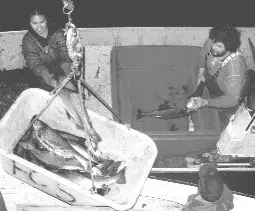Large halogen lights shine across the Fisherman’s Wharf and over the water beside the Alberni Quay as hundreds of Tseshaht and Hupacasath fishers sell their late-night Chinook catches to waiting buyers.
The wharf is a constant frenzy of activity as fishers empty their catches into steel brailers, which are then hoisted 20-feet up onto the dock by a truck crane and dumped into large plastic totes. When the brailer door is opened, hundreds of pounds of large, slippery Chinook slide out, slapping against each other as the drop into the tote. Small forklifts noisily push the filled totes across the rough asphalt dock surface and load them into waiting transport trucks which then rush the fish to plants in Parksville, Nanaimo, and Vancouver for processing.
Workers clad in glowing orange and yellow high-visibility vests scurry across the dock as they fill out fish slips, which are then handed off to the fishers who rush to buyers to settle their accounts.
The Hupacasath / Tseshaht gillnet fishery opened at 8 pm, and by 11 pm the first boatloads of 20 to 50 lb. Chinook started making their way to the docks, fetching a price of $1.30 lb. As the fishery wound down at 1 a.m., buyers in gillnet packer boats were swarmed by the small runabouts when it was announced they were buying fish at $1.50 lb.
Commercial gillnetters have been receiving upwards of $3/lb. for their catch, and according to one buyer who did not want to be named, the reason for the drastic price difference is that commercial fishermen are well organized and can force a higher price from competing buyers. First Nations fishers he said, are not organized in a cooperative or unionized manner, and accept lower prices.
There has long been suspicion on the part of First Nations fishers that buyers organize amongst themselves to set low prices, but the buyer we spoke with claimed such allegations are untrue, and buyers are actively competing with each other to get the most fish at the lowest price.
It is estimated more than 145,000 Chinook will be returning to the Somass / Robertson Creek system, and the Tseshaht and Hupacasath First Nations sales fishery, commercial, and recreational user groups have each been allocated 35,000 fish.
The Hupacsath / Tseshaht fleet has already caught close to 12,000 Chinook, and has openings every third night, staggered with commercial openings except for a break during the annual Labour Day Port Alberni Salmon Derby.
By David Wiwchar







